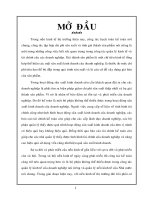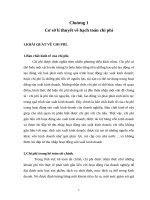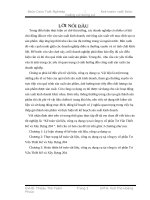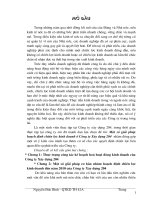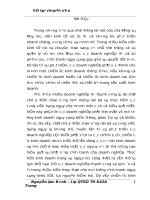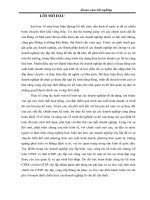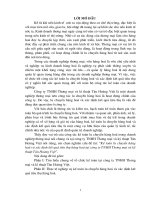GCSE 204
Bạn đang xem bản rút gọn của tài liệu. Xem và tải ngay bản đầy đủ của tài liệu tại đây (70.83 KB, 5 trang )
SƠ GD&ĐT VINH PHUC
TRƯƠNG THPT LIỄN SƠN
(Đề thi gồm: 05 trang)
ĐỀ KSCL ÔN THI THPT QG NĂM HỌC 2019-2020
BÀI THI MƠN: TIẾNG ANH 204
Thời gian làm bài: 60 phút, khơng kể thời gian phát đề
Ho va tên thi sinh:……………………………………………………………………. SBD:…………………………
Mark the letter A, B, C, or D on your answer sheet to indicate the word that differs from the
other three in the position of primary stress in each of the following questions.
Question 01. A. contractual B. significant
C. Asian
D. demanding
Question 02. A. majority
B. minority
C. partnership
D. enjoyable
Mark the letter A, B, C, or D on your answer sheet to indicate the underlined part that needs
correction in each of the following questions.
Question 03. My father has a mechanic to repair his motorbike monthly.
A. My father has
B. a
C. to repair
D. monthly
Question 04. Weather and geography conditions may determine the type of transportation used in a
region.
A. Weather
B. geography
C. type
D. used
Question 05. There always is one wise woman who is both feared and respected by her people.
A. always
B. wise
C. who is
D. by her people
Mark the letter A, B, C, or D on your answer sheet to indicate the correct answer to each of the
following questions.
Question 06. The class discussion was short. _________, we gained some new knowledge from it.
A. However
B. Moreover
C. Although
D. Therefore
Question 07. Do you know exactly_________ number of Siberian tigers in China?
A. a
B. an
C. the
D. 0 (zero article)
Question 08. Get going! All the students were_________ around, waiting until the last minute to go
into the building
A. dwelling
B. lingering
C. staggering
D. running
Question 09. 'I'm very_________ to you for putting in so much hard work,' the boss said.
A. thanking
B. grateful
C. considerate
D. careful
Question 10. He sat in a soft armchair and watched the world_________.
A. go by
B. pass on
C. walk along
D. fly past
Question 11. If it hadn’t been for the hint that the professor_________, nobody would have found out
the correct answer.
A. dropped
B. cast
C. threw
D. flung
Question 12. The international conference of the Craniological Association has been_________ in
Cairo to discuss the revolutionary discovery of Doctor Gonzales from Mexico.
A. deployed
B. collected
C. mobilized
D. summoned
Question 13. His parents have always wanted Philip to set a good_________ to his younger brothers
both at school and at home.
A. form
B. model
C. pattern
D. guidance
Question 14. The professor’s_________ theory is that singing preceded speech.
A. fancied
B. fond
C. pet
D. preferable
Question 15. Social work suits her_________ to the ground.
A. for
B. down
C. out
D. round
Question 16. He spent his entire life____________ round the world, never settling down anywhere.
A. roaming
B. scattering
C. scrambling
D. transporting
Question 17. You are under no obligation to help as assistance is purely_________.
A. voluntary
B. free
C. charitable
D. donated
Question 18. I’m afraid you may find the truth somewhat_________.
A. inedible
B. unpalatable
C. indigestible
D. unmanageable
Question 19. She’s very__________. She can be relied on to do her job properly.
A. efficient
B. cautious
C. serious
D. conservative
Mark the letter A, B, C, or D on your answer sheet to indicate the most suitable response to
complete each of the following exchanges.
Question 20. Andy: ‘Where can I get a cup of coffee?’
Murray: ‘_____________’.
A. No sugar, please.
B. I’d like coffee.
C. There’s a cafeteria downstairs.
D. I’m thirsty.
Question 21. Novak: ‘Could you tell me how to get to the post office?’ Ferrer: ‘_____________’.
A. Excuse me. Is it easy to get there?
B. Yes, I could.
C. It’s at the end of this street, opposite the church. D. Sorry, it’s not very far
Mark the letter A, B, C, or D on your answer sheet to indicate the word(s) CLOSEST in meaning
to the underlined word(s) in each of the following questions.
Question 22. Many people enrich themselves by taking educational classes.
A. damage
B. improve
C. help
D. research
Question 23. His business specialized in manufacturing vacuum cleaners.
A. selling
B. buying
C. making
D. fixing
Mark the letter A, B, C, or D on your answer sheet to indicate the word(s) OPPOSITE in
meaning to the underlined word(s) in each of the following questions.
Question 24. She had a cozy little apartment in Boston.
A. uncomfortable
B. warm
C. lazy
D. dirty
Question 25. He was so insubordinate that he lost his job within a week.
A. fresh
B. disobedient
C. obedient
D. understanding
Mark the letter A, B, C, or D on your answer sheet to indicate the sentence that is closest in
meaning to each of the following questions.
Question 26. “That’s a lovely new dress, Jane,” said her mother.
A. Jane’s mother said that she liked her lovely dress.
B. Jane’s mother wanted to buy a lovely new dress.
C. Jane’s mother complimented her on the lovely new dress.
D. Jane’s mother told her to buy that lovely new dress.
Question 27. We have run out of the items you want.
A. We have to run out to buy the items you want. B. The items you want are out of our
shop.
C. For the items you want, we must run out.
D. The items you want have been out of stock.
Question 28. Be sure to get me some newspapers.
A. I’m not sure about some newspapers.
B. I certainly will get you some newspapers.
C. Surely I’m going to get some newspapers.
D. Remember to get me some newspapers.
Mark the letter A, B, C, or D on your answer sheet to indicate the sentence that best combines
each pair of sentences in the following questions.
Question 29. You should listen to the radio. You can be kept informed about current affairs.
A. Only by listening to the radio you can keep yourself informed current affairs.
B. Listening to the radio and you will be kept informed about current affairs.
C. A good way of keeping yourself informed about current affairs is listen to the radio.
D. Listening to the radio is a good way of keeping yourself informed about current affairs.
Question 30. You didn’t listen to me in the first place. You are in trouble right now.
A. If you had listened to my advice in the first place, you wouldn’t have been in trouble right
now.
B. Had you listened to my advice in the first place, you wouldn’t be in trouble right now.
C. If you listened to my advice in the first place, you wouldn’t be in trouble right now.
D. Were you to listen to my advice in the first place, you wouldn’t be in trouble right now.
Read the following passage and mark the letter A, B, C, or D on your answer sheet to indicate
the correct word or phrase that best fits each of the numbered blanks.
If you are an environmentalist, plastic is a word you tend to say with a sneer or a snarl. It
has become a symbol of our wasteful, throw-away society. But there seems little doubt it is here to
stay, and the truth is, of course, that plastic has brought enormous (31)_________ even
environmental ones. It's not really the plastic themselves that are the environmental evil - it's the
way society chooses to use and abuse them.
Almost all the 50 or so different kinds of modern plastic are made from oil, gas or coal-nonrenewable natural (32)_________. We import well over three millions tones of the stuff in Britain each
year and, sooner or later, most of it is thrown away. A high (33)_________ of our annual consumption
is in the form of packaging, and this constitutes about 7% by weight of our domestic refuse. Almost
all of it could be recycled, but very little of it is, though the plastic recycling (34)_________ is growing
fast.
The plastics themselves are extremely energy-rich - they have a higher calorific value than
coal and one (35)_________ of "recovery" strongly favoured by the plastic manufacturers is the
conversion of waste plastic into a fuel.
Question 31. A. savings
B. pleasures
C. benefits
D. profits
Question 32. A. processes
B. resources
C. products
D. fuels
Question 33. A. amount
B. proportion
C. portion
D. rate
Question 34. A. industry
B. manufacture
C. plant
D. factory
Question 35. A. medium
B. method
C. measure
D. mechanism
Read the following passage and mark the letter A, B, C, or D on your answer sheet to indicate
the correct answer to each of the questions.
The hard, rigid plates that form the outermost portion of the Earth are about 100
kilometers thick. These plates include both the Earth's crust and the upper mantle. The rocks of
the crust are composed mostly of minerals with light elements, like aluminum and sodium, while
the mantle contains some heavier elements, like iron and magnesium. Together, the crust and
upper mantle that form the surface plates are called the lithosphere. This rigid layer floats on the
denser material of the lower mantle the way a wooden raft floats on a pond. The plates are
supported by a weak, plastic layer of the lower mantle called the asthenosphere. Also like a raft on
a pond, the lithospheric plates are carried along by slow currents in this more fluid layer beneath
them.
With an understanding of plate tectonics, geologists have put together a new history for the
Earth's surface. About 200 million years ago, the plates at the Earth's surface formed a
“supercontinent” called Pangaea. When this supercontinent started to tear apart because of plate
movement, Pangaea first broke into two large continental masses with a newly formed sea that
grew between the land areas as the depression filled with water. The southern one - which
included the modern continents of South America, Africa, Australia, and Antarctica - is called
Gondwanaland. The northern one - with North America, Europe, and Asia - is called Laurasia.
North America tore away from Europe about 180 million years ago, forming the northern Atlantic
Ocean. Some of the lithospheric plates carry ocean floor and others carry land masses or a
combination of the two types. The movement of the lithospheric plates is responsible for
earthquakes, volcanoes, and the Earth's largest mountain ranges. Current understanding of the
interaction between different plates explains why these occur where they do. For example, the
edge of the Pacific Ocean has been called the “Ring of Fire” because so many volcanic eruptions
and earthquakes happen there. Before the 1960's, geologists could not explain why active
volcanoes and strong earthquakes were concentrated in that region. The theory of plate tectonics
gave them an answer.
Question 36. With which of the following topics is the passage mainly concerned?
A. The contributions of the theory of plate tectonics to geological knowledge
B. The mineral composition of the Earth's crust
C. The location of the Earth's major plates
D. The methods used by scientists to measure plate movement
Question 37. According to the passage, the lithospheric plates are given support by the________.
A. upper mantle
B. ocean floor
C. crust
D. asthenosphere
Question 38. The author compares the relationship between the lithosphere and the
asthenosphere to which of the following?
A. Lava flowing from a volcano
B. A boat floating on the water
C. A fish swimming in a pond
D. The erosion of rocks by running water
Question 39. The word “one” in the passage refers to________.
A. movements
B. masses
C. sea
D. depression
Question 40. According to the passage, the northern Atlantic Ocean was formed when________.
A. Pangaea was created
B. plate movement ceased
C. Gondwanaland collided with Pangaea D. parts of Laurasia separated from each other
Question 41. Which of the following can be inferred about the theory of plate tectonics?
A. It is no longer of great interest to geologists.
B. It was first proposed in the 1960's.
C. It fails to explain why earthquakes occur.
D. It refutes the theory of the existence of a supercontinent.
Question 42. The paragraph following the passage most probably discusses________.
A. why certain geological events happen where they do
B. how geological occurrences have changed over the years
C. the most unusual geological developments in the Earth's history
D. the latest innovations in geological measurement
Question 43. In the passage, the word “concentrated” is closest in meaning to which of the following?
A. allowed
B. clustered
C. exploded
D. strengthened
Mark the letter A, B, C, or D on your answer sheet to indicate the word whose underlined part
differs from the other three in pronunciation in each of the following questions.
Question 44. A. benefit
B. sentence
C. get
D. bed
Question 45. A. fats
B. dates
C. dads
D. states
Read the following passage and mark the letter A, B, C, or D on your answer sheet to indicate
the correct answer to each of the questions.
The changing profile of a city in the United States is apparent in the shifting definitions
used by the United States Bureau of the Census. In 1870 the census officially distinguished the
nation's “urban” from its “rural” population for the first time. “Urban population” was defined as
persons living in towns of 8,000 inhabitants or more. But after 1900 it meant persons living in
incorporated places having 2,500 or more inhabitants. Then, in 1950 the Census Bureau radically
changed its definition of “urban” to take account of the new vagueness of city boundaries. In
addition to persons living in incorporated units of 2,500 or more, the census now included those
who lived in unincorporated units of that size, and also all persons living in the densely settled
urban fringe, including both incorporated and unincorporated areas located around cities of
50,000 inhabitants or more. Each such unit, conceived as an integrated economic and social unit
with a large population nucleus, was named a Standard Metropolitan Statistical Area (SMSA).
Each SMSA would contain at least (a) one central city with 50,000 inhabitants or more or
(b) two cities having shared boundaries and constituting, for general economic and social
purposes, a single community with a combined population of at least 50,000, the smaller of which
must have a population of at least 15,000. Such an area included the county in which the central
city is located, and adjacent counties that are found to be metropolitan in character and
economically and socially integrated with the county of the central city. By 1970, about two-thirds
of the population of the United States was living in these urbanized areas, and of that figure more
than half were living outside the central cities.
While the Census Bureau and the United States government used the term SMSA (by 1969
there were 233 of them), social scientists were also using new terms to describe the elusive,
vaguely defined areas reaching out from what used to be simple “towns” and “cities”. A host of
terms came into use: “metropolitan regions,” “polynucleated population groups”, “conurbations,”
“metropolitan clusters,” “megalopolises,” and so on.
Question 46. What does the passage mainly discuss?
A. How cities in the United States began and developed
B. Solutions to overcrowding in cities
C. The changing definition of an urban area
D. How the United States Census Bureau conducts a census
Question 47. According to the passage, the population of the United States was first classified as
rural or urban in________.
A. 1870
B. 1900
C. 1950
D. 1970
Question 48. Which of the following is NOT true of an SMSA?
A. It has a population of at least 50,000
B. It can include a city's outlying regions.
C. It can include unincorporated regions. D. It consists of at least two cities.
Question 49. The Census Bureau first used the term “SMSA” in________.
A. 1900
B. 1950
C. 1969
D. 1970
Question 50. Prior to 1900, how many inhabitants would a town have to have before being defined
as urban?
A. 2,500
B. 8,000
C. 15,000
D. 50,000
__________HẾT_________
